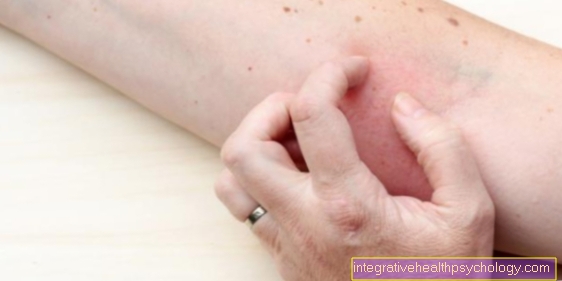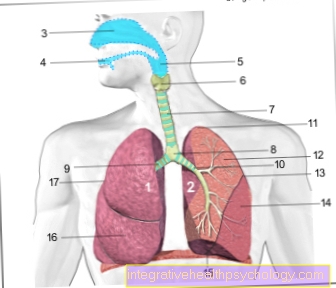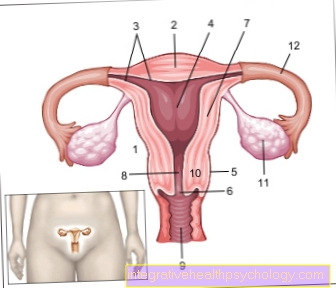Syphilis symptoms
Symptoms of Syphilis
Only about half of all infections with T. pallidum leads to a symptomatic course. It will four different stages differentiated:
1st stage

Stage I. of Syphilis symptoms (Primary stage) includes the incubation time, the occurrence of the primary effect and the time of its spontaneous regression. The incubation period from infection to the appearance of the first symptoms syphilis is an average of 3 weeks, in exceptional cases 1 week to 3.5 months. During this time, the pathogen multiplies at the point of entry up to a concentration of approx. 107 / g tissue.
The primary effect is a rough ulcer (Ulcer) with a raised rim, which is also harder or Ulcer durum is called. It is the size of a little fingernail, round, painless and produces a clear liquid. It is usually located in the genital area, but can also be outside the genital area (extragenital) be located anywhere on the body, e.g. at the lip, chest, Fingers. In such cases the Ulcus durum easily overlooked or misinterpreted. In addition, the Ulcer hide in body orifices, e.g. B. in the vagina or in the anus, and is then usually only discovered by chance or not at all.
The primary effect of syphilis is highly infectious (highly contagious), as it contains numerous living pathogens. About a week after the Ulcer the one near the Ulcer lying (regional) Lymph nodes (Lymphadenopathy). The knot feels hard, is easy to move and painless. This lymph node is also called a satellite bubo. The complex of the primary effect and the satellite bubo is called the primary complex.
Symptoms of the primary effect heal spontaneously 3–6 weeks after onset, but the lymph node swelling can persist for months.
2nd stage
Stage II of syphilis (secondary stage) includes the time when the body deals with the pathogen. It develops about 6-12 weeks after infection due to the hematogenous spread (Generalization) the pathogen and consists of organ manifestations that are characterized by a large number of pathogens and a high risk of infection. Especially symptoms such as changes in the skin (Skin manifestation) can be detected at this stage, but also fever, fatigue, headache, sore throat and body aches, swelling of the tonsils with whitish coatings and hoarseness (Syphilitic angina), enlargement of the spleen, and general swelling of the lymph nodes may occur.
The most important skin manifestations include the so-called Roseola syphilitica, the Condylomata lata, the Plaques muqueuses and the Alopecia.
Rose lichen is a harmless skin disease that can be confused with the symptoms of sypilis.
The Roseola syphilitica occurs in 75-100% of patients and consists of a pale, spotty (macular) Skin rash (Rash), which is mainly limited to the upper body (trunk). As a specialty, the palms of the hands and the soles of the feet can also be affected (Palmoplantar syphilid). The spots of the rash turn into vesicles over time (Papules) and then heal with or without treatment and usually leave behind light (hypo-) and dark (hyperpigmented) Put.
In the genital area, under the chest and between the fingers and toes, wide, soft, superficially oozing and highly infectious papules, called condylomata lata, form.
The plaques muqueuses are also highly infectious papules that are located on the mucous membrane, i.e. in the mouth, on the tongue, but also in the vagina.
If the scalp is attacked, irregular hair loss occurs, known as syphilitic alopecia.
The symptoms of the secondary stage subside 2–6 weeks after onset. However, it can return if the disease is left untreated.
After stage II of syphilis, either spontaneous healing, latency or stage III can occur.
Latency is the period of time after the primary effect has healed during which there are no clinical symptoms. It can last less than 1 year or last for a lifetime. The pathogen is also present in the body during the latency period, so antibodies against T. pallidum can also be found in the blood during this phase. The latency stage is divided into early latency, i.e. H. the clinical symptom-free time in the first 4 years after onset of the disease, and the late latency, d. H. the free time afterwards. Symptoms of secondary syphilis can reappear during the period of early latency, but usually only for up to a year.
The subdivision corresponds to the contagiousness (risk of infection) of the patient, which is high in the 1st year after the onset of the disease and then drops sharply. In late latency, the patient is no longer contagious, sexual partners are no longer infected, but there is still a risk of transmission from the mother to the fetus and through blood transmission.
The latency can be interrupted at any time by the appearance of symptoms of the disease of the secondary stage or the tertiary stage.
3rd stage
The Stage III of the syphilis (Tertiary stage) occurs in about 35% of all untreated syphilis cases 2-5 years on. At this stage are next to the skin also internal organs (liver, brain, aorta) affected, the stage is characterized by the following symptoms:
Specific new tissue formation (Granulomas) of the skin are gums and syphilids.
Gums are painless tumors / tumor of elastic consistency, which leads to melting (Gumma), Draining of stringy fluid and scarring. They arise in the subcutaneous tissue (Subcutis), the skin bulges and then disintegrates into sharply defined, coarse ulcers (Ulcer). Inside the gums there are few living pathogens that are responsible for their development. The rubbers are most commonly found in bone, Skin and mucous membranes. In the face and mouth they can lead to destruction (holes in the palate and nasal septum, saddle nose), in the bones to fractures, in the liver Jaundice (Jaundice).
Syphilids consist of brown-red, coarse, lentil-sized to bean-sized nodules that are clearly raised above the skin level. They can occur anywhere on the body, preferably on the extensor sides of the arms, but they can also affect the back and face and do not cause any discomfort.
The changes in the Heart and the vessels (cardiovascular) are based on vascular inflammation (Vasculitis) smaller and medium-sized Arteries and Veins (Endarteritis obliterans). This inflammation affects v. a. the blood vessels of the main artery (aorta), which serve to supply the aorta (Vasa vasorum). The wall tissue supplied by the vasa vasorum disappears, and the elastic fibers in the aortic wall disappear. An expansion forms (Dilation) the aorta, which extends to the point of expansion (Aneurysm) can develop. The rupture (Rupture) aneurysm is usually fatal. Often these are patients who have had syphilis decades before.
4th stage
To the Stage IV of the Syphilis symptoms or is one of the late forms Neurosyphilis. She will be in two Main forms divided:
1. In the Meningovascular Neurosyphilis especially blood vessels of the meninges (Meninges), brain tissue and Spinal cord infested. The inflammation of the vessels (Arteritis) there is a reduced blood flow and thus damage to the Nervous system. This can result in symptoms like Back pain, Sensory disorders, cramps Failure symptoms such as hemiplegia and Strokes result.
2. Typical symptoms of the Parenchymal neurosyphilis are the progressive paralysis (progressive paralysis) and the Tabes dorsalis.
Progressive paralysis is based on nerve cell destruction (preferably in the brain) and brain wasting (Brain atrophy), whereby the frontal lobe is particularly affected. It can dementiaMemory loss, megalomania, hallucinations, Speech disorders, Tremors, incontinence and convulsions occur.
In the Tabes dorsalis the spinal cord is predominantly involved. The patients suffer from lightning-like (lancinating) Pain and loss of temperature and vibration sensation, gait disorders, bladder emptying disorders, impotence, loss of the tendon reflex and light-rigid pupils.
Furthermore, there can also be changes in the Cerebral fluid (Cerebrospinal fluid) without clinical symptoms, i.e. asymptomatic neurosyphilis.
-> Continue to the topic of transmission of syphilis





























